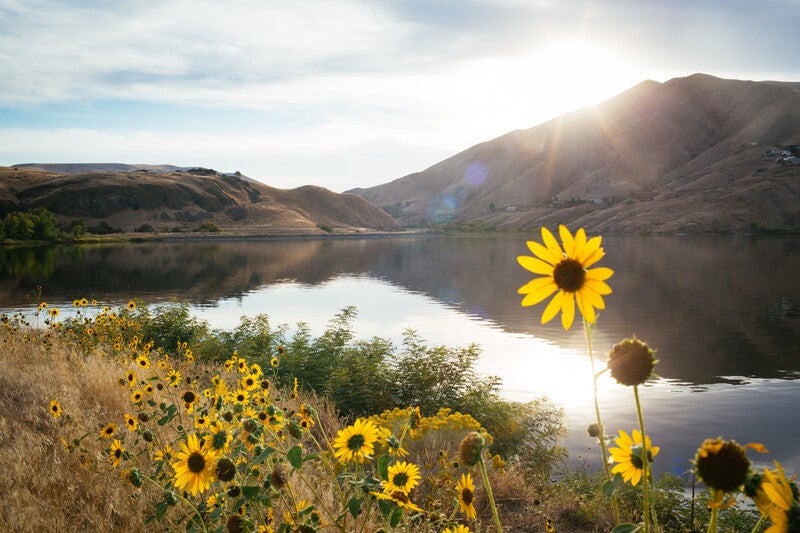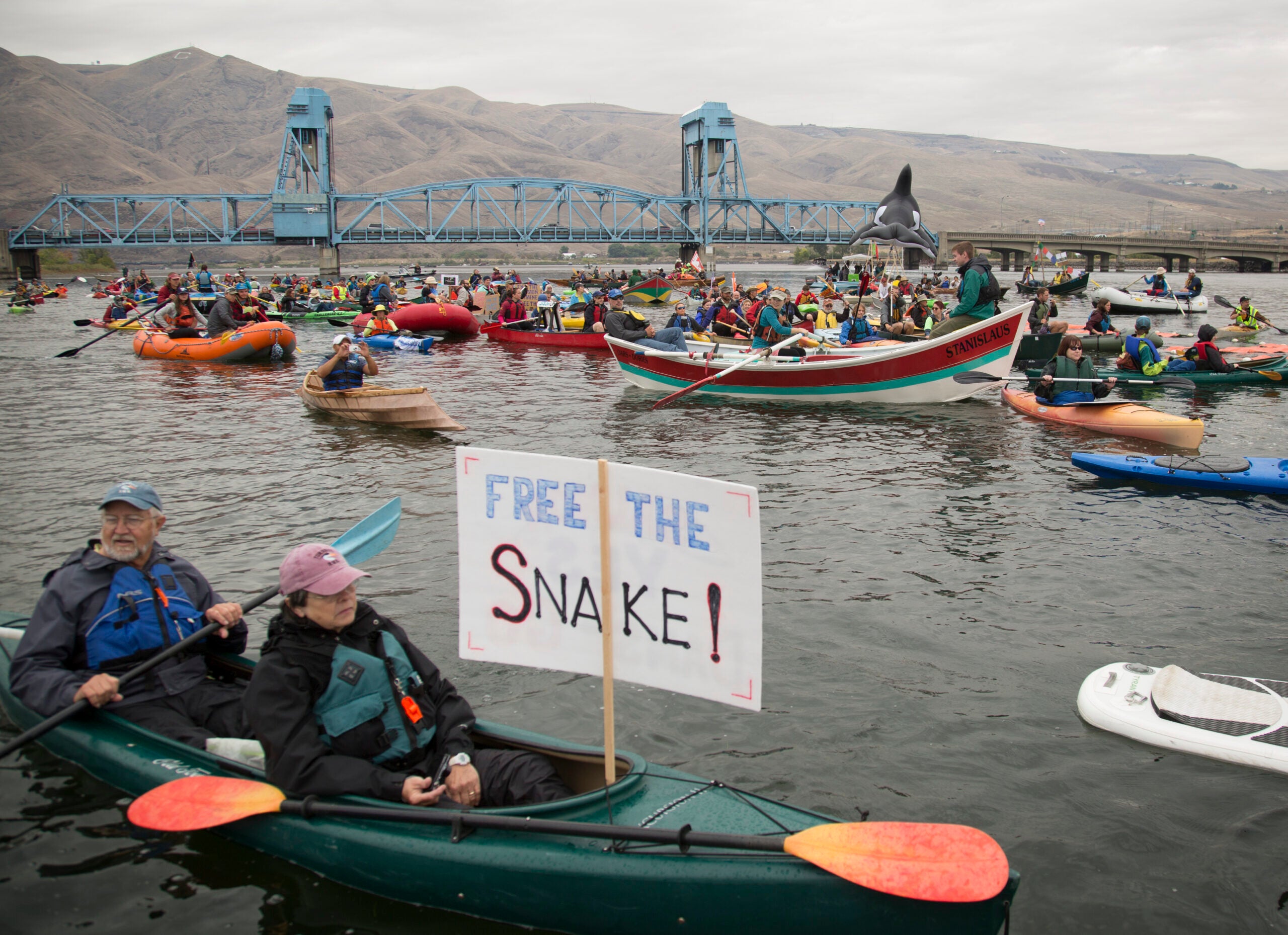Earthjustice goes to court for our planet.
We’re here because the earth needs a good lawyer.
Snake River Salmon Are in Crisis — But a Turning Point May Be Near
This page was published 2 years ago. Find the latest on Earthjustice’s work.
What Happened: In a memo issued in late September, President Biden ordered federal agencies to do everything in their power to restore wild salmon and steelhead populations in the Columbia and Snake rivers of the Pacific Northwest.
Why It Matters: Scientists have been clear: The remedy for plummeting salmon populations must include the removal of four federal dams on the Snake River that are pushing the fish towards extinction. For more than 25 years, conservation and fishing groups represented by Earthjustice have been litigating alongside Tribes to bring about the breaching of the dams. This litigation is now on hold while stakeholders negotiate a plan to protect the salmon.
Biden’s order is a promising sign that his administration will honor Tribal treaty rights and uphold environmental laws aimed at preventing species extinction. While Biden’s memo doesn’t explicitly call for the removal of the four Lower Snake River dams, removing the dams and replacing the services they provide is the approach we need to prevent extinction and eventually restore salmon to abundance.
Time is running out for salmon in the Snake River
- No time to waste: If we don’t act now, the remaining salmon in the Snake River face extinction. The river flows through Idaho, Oregon, and Washington. It is the largest tributary of the Columbia River, once among the greatest salmon-producing river systems on Earth.
- The problem: Four dams in Washington block salmon passage along the lower Snake River, which is a major migration route linking habitat in central Idaho to the Columbia River and out to the Pacific Ocean.
- Science-backed solution: Science is clear that removal of the four lower Snake River dams — Ice Harbor, Little Goose, Lower Monumental, Lower Granite — is the single best thing we can do to save salmon from extinction and restore their populations to abundance.
The power of the law requires the federal government to protect the salmon
- A loss we can’t afford: Salmon are critical to Pacific Northwest ways of life, economies, and ecosystems. The loss of salmon is unacceptable to all of us, and especially to the Tribal Nations whose culture, traditions, and ways of life depend on them.
- Binding treaties: When each of the four Columbia River Basin Tribes signed treaties with the United States in 1855, they explicitly reserved their right to fish in perpetuity while ceding significant portions of their traditional territory to the government. These treaties still bind the U.S. government today.
- Endangered Species Act obligations: Nearly all the salmon in the Columbia basin are listed as endangered or threatened under the Endangered Species Act. This status requires the federal government to take certain actions to protect the fish.
- The government’s duty: By failing to remove the dams, the government is violating these obligations.
- A long fight: Earthjustice’s clients in decades-long litigation to compel dam removal include National Wildlife Federation, Sierra Club, National Sportfishing Industry Association, Northwest Energy Coalition, Idaho Conservation League, Idaho Rivers United, Columbia Riverkeeper, the Pacific Coast Federation of Fishermen’s Associations, Institute for Fisheries Resources, and Fly Fishers International. The Nez Perce Tribe and state of Oregon are also aligned with these groups.

Sun sets on a dammed section of the Snake River in between Lower Granite dam and Lewiston, ID near Chief Timothy Park. (Chris Jordan-Bloch / Earthjustice)
A turning point in the fight
- Pausing for negotiations: There is an urgent need for Pacific Northwest policymakers, the Biden administration, Tribal Nations, and other stakeholders to develop comprehensive plans to restore the lower Snake River and replace the services provided by the dams. Earthjustice’s litigation is on pause until Oct. 31 while negotiations take place among these groups.
- A dam ramp-down plan: This spring, the Washington State Legislature confirmed that honoring Tribal treaty rights and saving Snake River salmon from extinction are top priorities. It released a 2023-25 State Transportation and Operating Budget with funding for next steps to recover salmon, restore the lower Snake River, and maintain clean energy and agriculture in the region.
- Momentum in D.C.: Support for strong action to recover healthy and abundant salmon populations in the Columbia-Snake River system is growing among leaders on Capitol Hill:
- In 2021, Representative Simpson of Idaho released a comprehensive Columbia Basin Initiative that proposed breaching the four lower Snake River dams and replacing their services in order to prevent salmon extinction.
- In 2022, Governor Inslee and Senator Murray of Washington published a report and recommendations calling salmon extinction “categorically unacceptable” and urging immediate action to make breaching the lower Snake River dams possible.
- And in 2023, Representatives Blumenauer, Salinas, and Hoyle sent a letter to President Biden in support of his Presidential Memorandum on Columbia River Basin salmon recovery.
- The final say: The four lower Snake River dams are federally owned and operated, and the final decision of breaching will be made by the federal government.

Hundreds of people from the Pacific Northwest and beyond have gathered at the confluence of the Lower Snake and Clearwater Rivers to call for the restoration of our wild salmon by removing four costly dams on the Lower Snake River. (Chris Jordan-Bloch / Earthjustice)
Why Biden’s memo is a good sign
- A mandate for salmon health: While there is no mention of dam removal, the presidential memo directs federal agencies to use all of their authority to restore healthy and abundant wild salmon, steelhead, and native fish populations across the Columbia and Snake River Basin and to review and update any policies not aligned with that goal. Federal agencies cannot comply with this directive without addressing the four lower Snake River dams.
- The government’s own experts say dam removal is necessary: A 2022 report by the National Oceanographic and Atmospheric Administration (NOAA) called for dam removal among numerous actions needed to rebuild endangered salmon and steelhead populations.
- Committing to the future: The memo is part of the administration’s stated commitment to “honor the United States’ obligations to Tribal Nations and protect and restore America’s natural wonders for future generations.” President Biden has said it is time for a “sustained national effort to restore healthy and abundant native fish populations in the Basin” marking it as a national priority.
- We must keep the pressure up: There is no time to waste. Contact your elected officials and ask them to support the Biden administration’s actions to restore health and abundant salmon to the Snake River and uphold commitments to Northwest Tribes.
